Millions of tourists flock in Siem Reap every year to visit the famous UNESCO World Heritage temples of Angkor. While these temples are the highlight of every tourist visiting Cambodia, the countryside of Siem Reap tends to be overlooked and only a few chooses to explore off the beaten track and get to experience the beauty of Cambodia’s authentic rural lifestyle.
About five kilometers away from the busy Siem Reap downtown area, one can find picturesque and tranquil scenary of villages with small traditional houses scattered throughout the expanse of the countryside. People are warm and they are almost all the time happy to pose for photographs. Main photography themes would be landscape photography of the green paddy and lotus flower fields, farmers working in the plains, amazing sunsets, and portrait opportunities of kids from the village.
Angkor Photography Tours offers photography tours in Siem Reap to photography enthusiasts who wants to see and capture rural living.
These photographs were taken during our tours and will hopefully entice you to take a day or two of your visit in Siem Reap to explore the lovely Cambodian countryside.
Running photography tours in the temples of Angkor for the last 5 years, I am particularly acquainted the Angkor Archaeological Park which stretched over 400 square meters and counts more than 200 temples. I want to share with you some tips that will help you capture better pictures during your stay in Cambodia. From the preparation to the actual day, here are 10 photography tips below on how to get the best out of your day in the temples of Angkor.
If you are looking for photographing away from the crowd and explore hidden temples please checkout our E-Bike Hidden Temples of Angkor photo tour.
A wide angle lens is a must in the temples of Angkor. Unfortunately many people realized too late that their lens is not wide enough ….I would recommend at least a 24 mm (on a full frame) or a 10 mm (on a crop sensor). Many of the temple photography was taken at 17 mm or 20 mm.
If you have a Canon camera, I would suggest the moderately-priced ultra wide zoom lens Canon EF 17-40mm f/4L USM or the more expensive Canon EF 16-35mm f/2.8L USM. In some instances you may want to bring or rent a telephoto lens as it can be useful in some temples like Bayon to isolate the distant faces or capture far details in other temples. If you have a Canon camera, I would suggest the Canon EF 70-200mm f/4L USM or the more expensive version Canon EF 70-200mm f/2.8 L USM.
If you have a Fisheye lens taking the dust in one of your drawers, I strongly suggest to take it to Angkor, it is a fun lens to use in the temples. Pictures below ere taken with the 7artisans fisheye 7.5 mm f:2.8.
Photography tips Angkor Wat: be creative with your fish-eye lens capturing devatas in Angkor Wat temple
Photography tips Angkor Wat: be creative with your fish-eye lens capturing the giants trees of Angkor
You will probably take more pictures than usual during your photo tour and test the limit of your camera’s battery life. I noticed that cameras with electronic view finders (Sony Alpha 7r, 7s, Olympus OMD5 or Pen) drain their batteries quite fast so having extra batteries is highly recommended for mirrorless cameras. With Canon and Nikon DLSR’s, you can get away with one battery (if new) if you use from time to time your LCD screen. Be sure to charge fully the battery the night before. If you do not have an extra battery I highly recommend to bring your charger. There will be some charging stations at the restaurants around Angkor so you charge your batteries during your lunch break or coffee break.
Many photographers are coming to Angkor with a tripod and end up not using it. It would be difficult to use a tripod at the sunrise in Angkor Wat unless you arrive very early and take a position in front of the crowd. Generally you can get away in taking Angkor Wat sunrise pictures without a tripod by using a large aperture and raising a bit the ISO. Light inside the temples can be quite low even in the afternoon but you can still get pretty decent photos in most cases by raising ISO to 1000. If you want to keep the noise low, one option is to use a monopod so you can use a lower speed. A monopod is also much easier to carry than a tripod.
Some people sometime ask if tripods are allowed in the temples of Angkor. The short answer is yes… However if you look “too professional” someone might ask you if you have a permit for shooting as they might think that you are shooting a commercial work.
Tourists lined up in front of the reflecting pond facing Angkor Wat temple
Sunrise at Angkor Wat is a very popular venue all year round and it is best to arrive early to get your spot in front especially if you want to set up a tripod. 5 am is the earliest that you can enter Angkor Wat. The day before your planned tour, you can check sunrise time on Google. Leaving your hotel one hour before sunrise would be ideal. During the months of June, July and August, as sunrise is very early, I suggest that you buy your pass the day before from 5 pm at the new ticket center close to the Angkor Panorama Museum.
If you are planning to stay for several days and explore more temples, the best value for money is the 7-day pass at USD 72 which will allow you entry to the park 7 times for a period of 30 days. The worst deal is the one-day pass at USD37 , especially if you plan to visit the temples only half a day. To know more about the Angkor tickets please read our blog post.
Light in the temples of Angkor can be quite difficult to master especially at midday so it is best to shoot before 10 am and after 4pm. It does not mean of course that you cannot take good shots in between you just have to look for light and shadows.
Devata in Ta Prohm temple emerging from the shadow
Head of a Devata in the morning light at Angkor Wat temple
Angkor Wat is such a massive temple that it is easy to miss many interesting details. Just look closely at the carvings and writings carved into the sandstone they can are often beautiful to capture. Do not forget also to look up the ceiling in the hall of 1000 Buddhas. If you want to see more close up pictures of Angkor please have a look at our previous blog entries here and here.
Bas relief detail in Bayon temple
Photography tips Angkor Wat: do not forget to look up in Angkor Wat temple to see these motifs with preserved red pigments
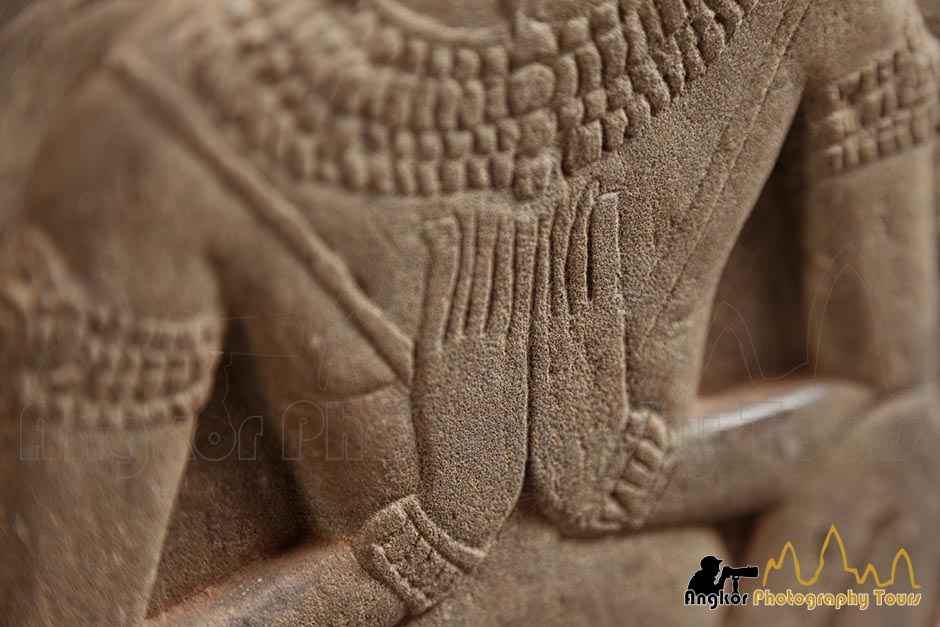
Hindu priest carving details in Angkor Wat temple
Getting the right exposure for your pictures in Angkor can be tricky as light changes drastically between outside and in the temple and change as well quite quickly outside. Unless you are shooting on auto ISO you will have to always pay attention to your ISO settings first before clicking your camera. Whether you are shooting manual or priority aperture, the metering system of your camera will be often challenged so you would to change quite often your camera settings. It is often said that shooting against the sun is a not a good idea but by choosing the right settings in your camera it can give fantastic results as you can see on the picture below.
Beautiful Apsara carvings at sunrise
Even in the busiest temples of Angkor Wat, Ta Prohm and Bayon, you can escape the crowd by sauntering thru smaller corridors where you will often find hidden treasures that most tourist wouldn’t find.
Photography tips Angkor Wat: get out of the beaten path
When in Siem Reap, many travel agents or independent drivers will recommend Phnom Bakheng as the best sunset viewpoint. It is actually the worst ! You would have to go there quite early as the numbers of people allowed on top of the temple is now limited to 300. The sunset view is not that impressive. You can see Angkor Wat from there but will need a least a 300 mm lens to take a decent shot. This useful website can help you find out other sunset spots in Angkor. Bear in mind that most of the temples are open only between 7.30 am to 5.30 pm which will make sunset pictures impossible. Beside Phnom Bakheng the only places which are opened until 7.00 pm are Pre Rup temple and Srah Srang.
Sunset at Angkor Thom
Running photography tours in the temples of Angkor, I am one of the lucky few who have witnessed and captured nearly 200 sunrises. Although there were days when sunrise was uneventful, Angkor Wat sunrise it is a special moment to capture although it became quite popular over the years. It is always a new spectacle depending on the weather and also due to the fact that sun rise is actually moving from the south to the north of the temple. Twice a year, during the equinox of March and September, sun rises just behind the main tower which make the sunrise even more spectacular.
Here is a selection below of the best sunrise pictures I took the past few years in Angkor Wat temple. If you are a photographer and want to get professional advice and tips during Angkor Wat and beyond please have a look at our popular Angkor Wat sunrise tour.
The last solar eclipse making the headlines in Angkor was the one on the 24th October 1995. It was a total eclipse reaching its maximum just before noon. As the sun was already high in the sky, no picture could be taken with the silhouette of Angkor Wat.
The recent solar eclipse that took place on March 9th 2016 received almost the same attention from the media. In a narrow corridor stretching from Sumatra to Sulawesi in Indonesia, the eclipse was total but only partial in other parts of Southeast Asia: Malaysia, Singapore, Vietnam, Philippines, and Cambodia.
As the date of this eclipse was close to the Spring Equinox celebration where the central tower of Angkor Wat is perfectly aligned with the rising sun, it was such a perfect timing for watching the sun rising behind the main towers of the temple. Sunrise on that day was at 6.16 am and the eclipse started at 6.39 am, reaching its maximum at 7:34 am and ended at 8.37 am.
As expected, the moon started passing in front of the sun just after sunrise. As the eclipse continued the sun was close enough to the main tower to capture a half-sun sitting right above the pinnacle of the main tower. It was also a good time to catch some reflection on the pond.
Another eclipse leaving only a crescent of sun above Angkor Wat will take place on April 20th 2042. Save the date, it should be another spectacular event, though with a maximum point at 8.06 am, the sun will already be quite high on the sky but the changing of light might be interesting.
(These pictures were taken with a Canon 5DMKII and a 24-105 mm f:4 lens fitted with a 10-stops neutral density filter)
Cambodia sits just about the equatorial zone where the weather is mostly warm to hot all year round. Just like all countries with tropical climates, there are only two seasons – the wet and the dry.
One of the recurring question among visitors and photographers is what is the best time to visit Siem Reap and Cambodia in general?
The dry season starts in October and ends in April and it usually lasts longer than the wet season. This is the time when scorching heat brought about by the northeast monsoon dries up the land turning the Cambodian countryside into spectacles of golden paddy fields and creating fine powdery white to tawny colored dusty dirt roads. There are cool months though, from November to January, which is also considered high season by many tour operators particularly in Siem Reap. Tourists flock the temples of Angkor at this time of the year as they make the most out of the cool weather without having to worry of being soaked in the rain. Around the months of January and March, hazy skies can be observed giving the sun a fiery red ball effect, perfect for capturing stunning sunset at the Angkor Thom moat as shown in the picture below.
On the other hand, wet season runs from May to September caused by the southwest monsoon. It tends to rain most days of the week, generally heavy downpours that usually last for a few hours. There are days when the rain is quite light but it continues all day long. Wet season in Cambodia means low season for tourism in Siem Reap and Angkor Wat. For tourists and photography enthusiasts, visiting during the wet season has its lovely perks. Aside from being less crowded, spectacular cloud formations and charming colors can be seen in the morning. The countryside looks more alive with lush foliage. The green scenery is quite striking amidst the drenched surroundings. The dusty dirt roads are now soggy mud pits and the meadows are flourishing with vegetation. The moats surrounding the temples are filled with water and there are pools of water everywhere ideal for taking reflection photos.
Some temples are putting up their green moss robe during the monsoon season as in Preah Khan and Ta Prohm temples. You can see more pictures of the temples of Angkor during the green season on our blog Cambodia Green Season.
Sunrise and sunset intervals also change during the seasons. In January, sun rises the latest at around 6:30am while in June, sun rises the earliest at around 5:30am. While the sun sets earliest in January normally around 5:30pm and not later than 6:00pm, it sets relatively late in June at around 6:30pm. Sun path also varies with the seasons. Angkor Wat in particular is exposed to a very different light in the months of June and December: standing on the central causeway you will see the sun rising on the right side or left side of the temple respectively. You can see below the dramatic change in light at the northern corridor.
Apart from the temples, the Cambodian countryside is changing drastically between the dry and the wet season with lotus and paddy fields appearing and disappearing from the landscape.
Each season has its advantages and disadvantages, nevertheless, if you are a photography aficionado, any season is a good season to visit Siem Reap and capture the beauty of Angkor.
To conclude, especially if you are a photographer, all year around is good to take pictures in Cambodia.
If you are heading to Cambodia soon and you are wondering about the weather in Siem Reap, you can have look at the live siem reap weather map below.
Green, the color of nature, is a symbol of life and harmony in a nourishing ecosystem and omnipresent during Cambodia monsoon season. Green, with its variety of hues, signifies abundance and growth radiating serenity and contentment to its surroundings and beholders. Green is a constant element of a landscape, a backdrop to all beautiful sceneries that captivates the human eye.
At the monsoon, the temples of Angkor are putting their green robes on . This season which starts in June and ends in October is also the low season for Cambodia’s tourism. Little did we know however that this is the time of the year that temples of Angkor seem like they are coming to life. Nature has its way of creating abundance of beauty each season but this impressive green color surrounding the already magnificent structures are a sight to behold. Patches of green grass are everywhere and stones are covered with moss with different shades from lime green to emerald green to sea green. Most of the time, rainy season does not attract a lot of photography enthusiasts because of challenges in exploring the temples. Nevertheless, those with adventurous and exuberant spirit make the most out of this period to take distinctive photos. Aside from the green patches, there are countless pools of water everywhere, big and small, where reflection shots can be taken.
In Banteay Kdei and Beng Mealea for example, where it is normally dry all year round, green ponds are also emerging which makes taking photos more exciting.
Sunrise at Angkor Wat , a very famous sighting for tourists, with thousands of spectator watching the sun rising above the five towers of Angkor Wat, flaunts the most spectacular show during the monsoon season. The lush carpet of green grass surrounding the magnificent temple and the gorgeous lily pond that reflects green and blue provides the most striking contrast to the golden glow of sunrise.
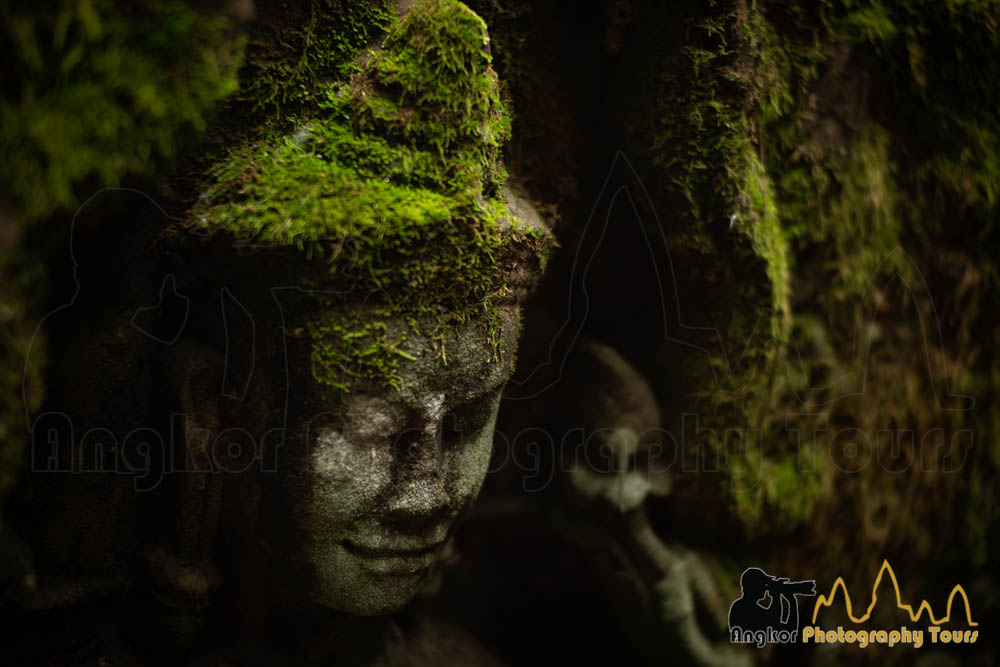
Cambodia monsoon season: Devata carving covered in moss
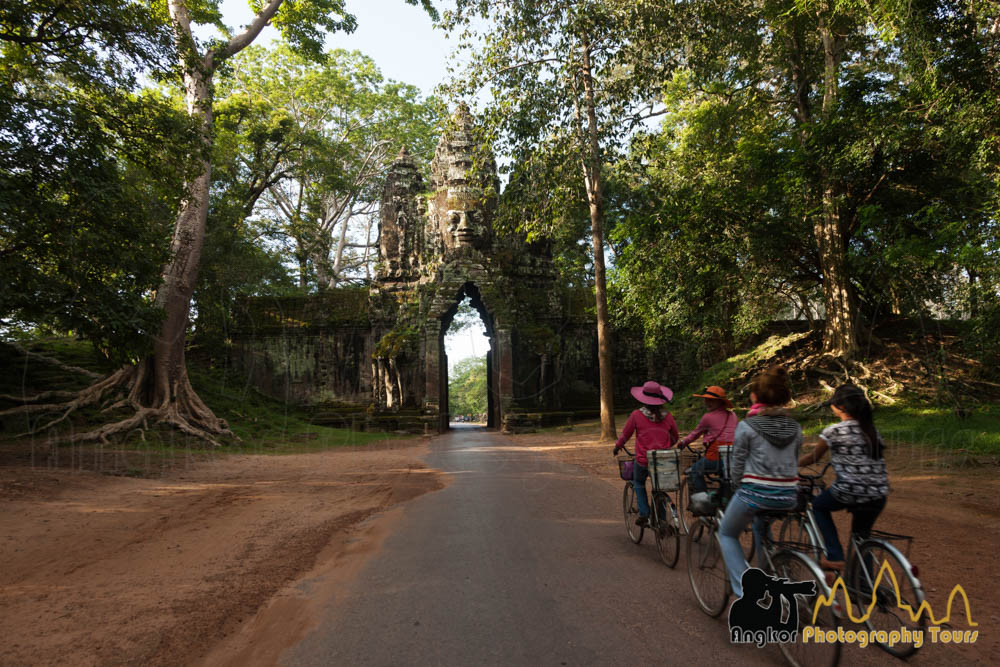
Local women on bicycles about to enter one of the gates of Angkor Thom
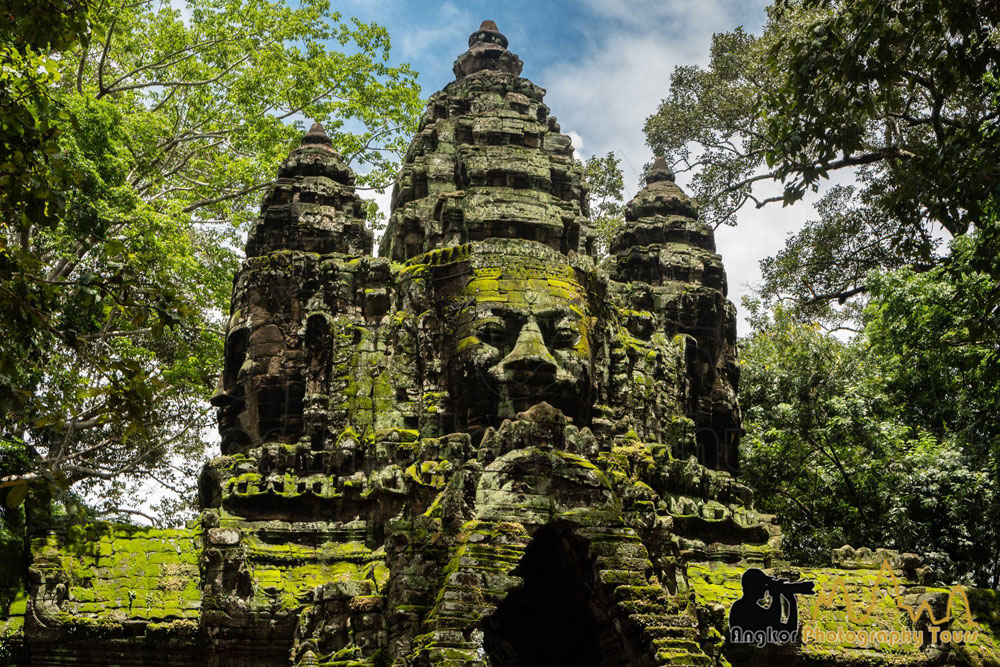
Angkor North Gate (September 2011)
Remain of a statue torso in one of gate of Angkor Thom
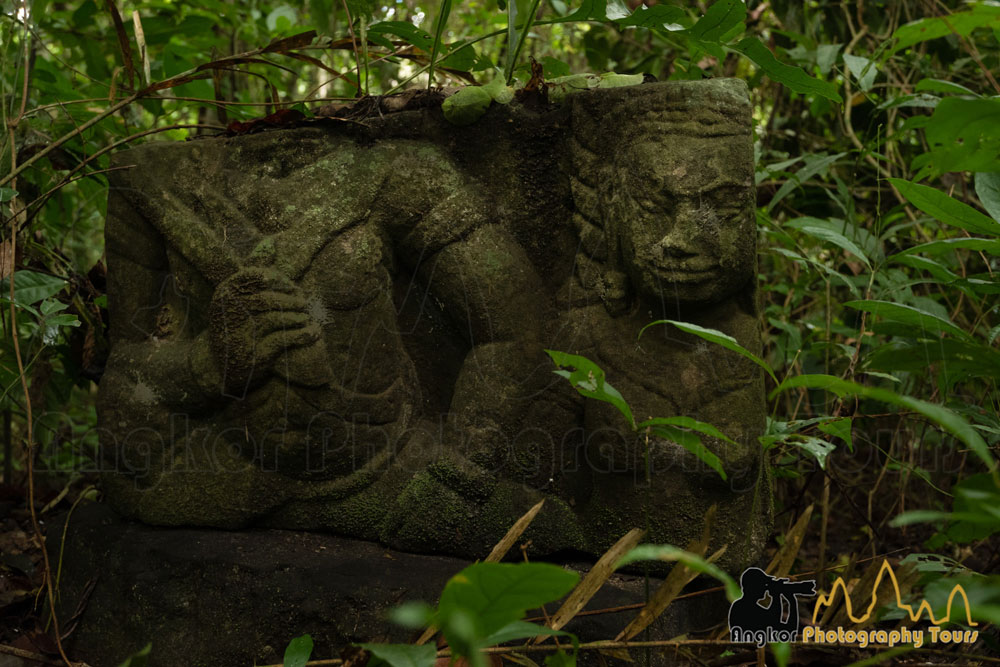
Hidden carving in Angkor
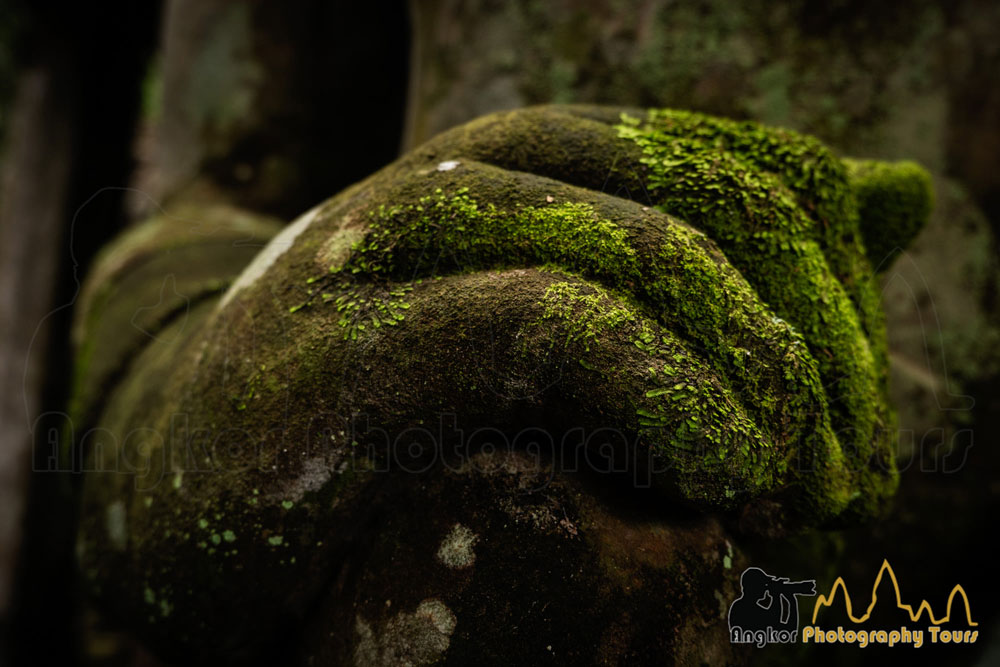
Guardian statue hand covered with moss

Beautiful Garuda carving during Cambodia monsoon
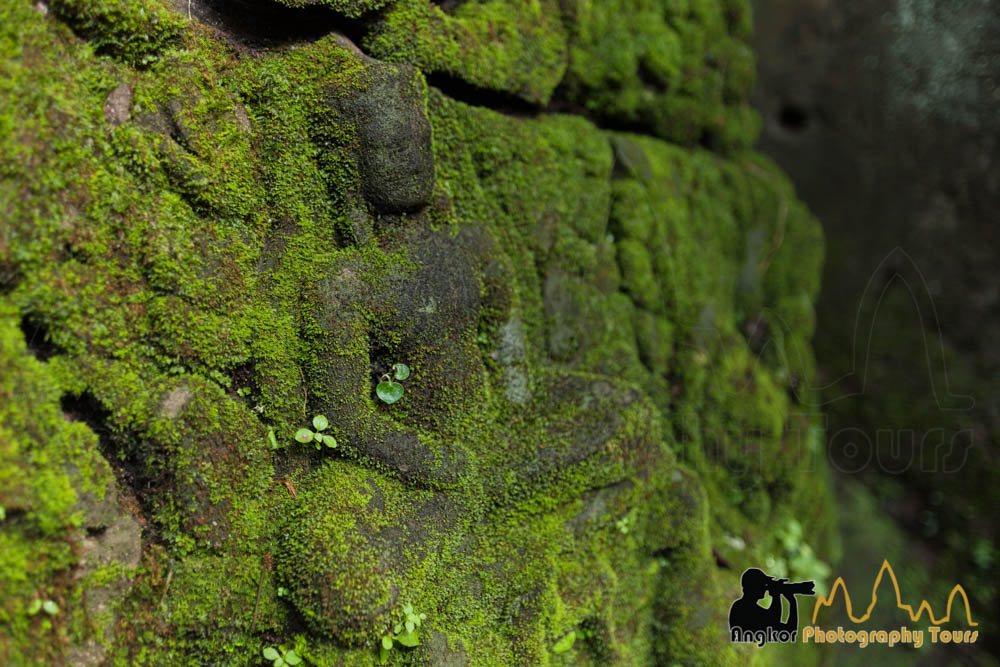
Cambodia monsoon season: Buddha carving covered with moss at Preah Khan temple

Sandstone block with inscription covered with moss
Green pond in Beng Mealea temple